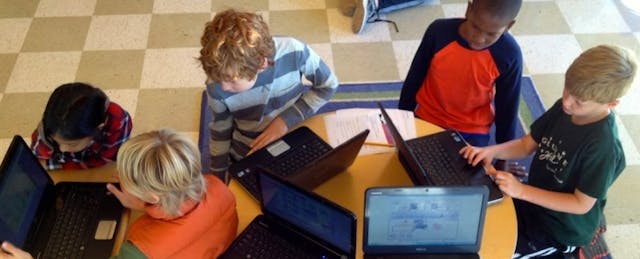Take a peek at Acton Academy and you may wonder if you’ve stepped into a mythical world where students are heroes, learning is a quest, and teachers are guides for the journey. In this one-room-schoolhouse approach, 36 K-5 students share one space, while 28 6-8th graders share another. The teacher is merely a guide, as students have autonomy in almost every facet of their learning.
At Acton, students make the rules over how to spend the time--and what technology to use. This radical model where edtech meets Montessori has proven an effective formula for success. Students gain an average of three grade levels each year in math, reading and language arts.
Five years after its start in 2008, this small private academy is looking for partners as it expands beyond Austin’s city limits and spread a model where kids control their learning journey--and the tools they use along the way.
Grab Your Cape And Be A Hero
At Acton, independence and autonomy is a powerful learning tool. These values are rooted in Joseph Campbell’s The Hero’s Journey, which has inspired the development of Acton’s curriculum. Students not only embark and reflect on their own journey filled with tests, allies, and enemies, but also examine how famous scientists, scholars, and historical figures heeded their own calls to adventure and roadblocks along the way.
Teaching is a key responsibility for students and an important part of their learning. Everyday, first and fifth graders work side-by-side, regardless of their skill level. Students are expected to take responsibility for themselves and for each other.
“The older students do an incredible job mentoring the really young ones,” says Founding Teacher, Kaylie Dienelt Reed. “Last year I paired fifth graders with first graders for reading time. I didn’t read with my first graders until they brought a book to me and could read it to me on their own.”
“I’ve had to live it to really understand how unbelievably independent the students are and when you give them freedom how seriously they take that responsibility,” Reed adds.
Teachers, on the other hand, are referred to as “guides.” “We are the curators of resources, we cheer the kids on and are there to have conversations when they need it,” says Reed. “If we step away, the students take charge.” Two to three guides are present in class at any time, producing a low student-to-teacher ratio no higher than 18:1. While teachers take a huge step back with students in class, they spend a great deal of time constructing quests and facilitating Socratic-style conversations.
Choose Your Own EdTech Adventure
After students spend the first part of the day in cross-grade, project-based assignments (called “quests”), they spend the other half mostly online practicing core skills: reading, writing, and math. They choose which of the three they want to work on, and more importantly, which tools to use.
“We are using blended learning to empower students…to give them control over their learning. We believe that unless they have control over their learning, they are not going to actually learn,” explains Reed.
In the school’s early years, says Reed, students and teachers scoured the Internet together, trying out every edtech product they could find and giving their teacher constant feedback on what they thought. Students found programs like Dreambox, which Reed said personally “drove her nuts.” However, the students stuck with it and “that’s when I realized that I can’t make these decisions, because these products aren’t designed for me, they are designed for a second grader,” she explains.
Currently, the math tools used by students include Dreambox, ALEKS, MagnaHigh, and Khan Academy. Other tech tools used by the school include Rosetta Stone, ClickN Kids, VoiceThread, and SpellingCity. As they try new tools, Reed asks for student feedback such as that how engaged they are, costs, whether they can give their parents access, and whether it offers data about their learning.
Central to the entire process is the idea that students are the ones who know their learning best and therefore, should be the ones calling the shots on purchasing decisions.
Growing Up
Now, Acton plans to open up its unique model and expand.
The school currently has a sister school in Guatemala. However, it hopes to find ten other partners in the United States who can open Acton schools in their communities. Each school is expected to retain the mission and guiding principles already established. There are currently twenty applicants interested.
Currently, Acton charges $865 per month. While Reed has toyed with the idea of expanding the model as a charter schools she explains, “there is more money in charter school than we probably need.” Once the model has been expanded to encompass grades K-12, the school hopes to drop tuition as low as $1,500 - $2,000 per year.
“We are convinced it works, and know it will get better and needs to get better. But we can’t hold onto this school model any longer, we have to share it,” says Reed.
As Acton grows, so too will the idea that kids could be in control of their edtech destinies, if only the adults would set them free on a quest to do so.


